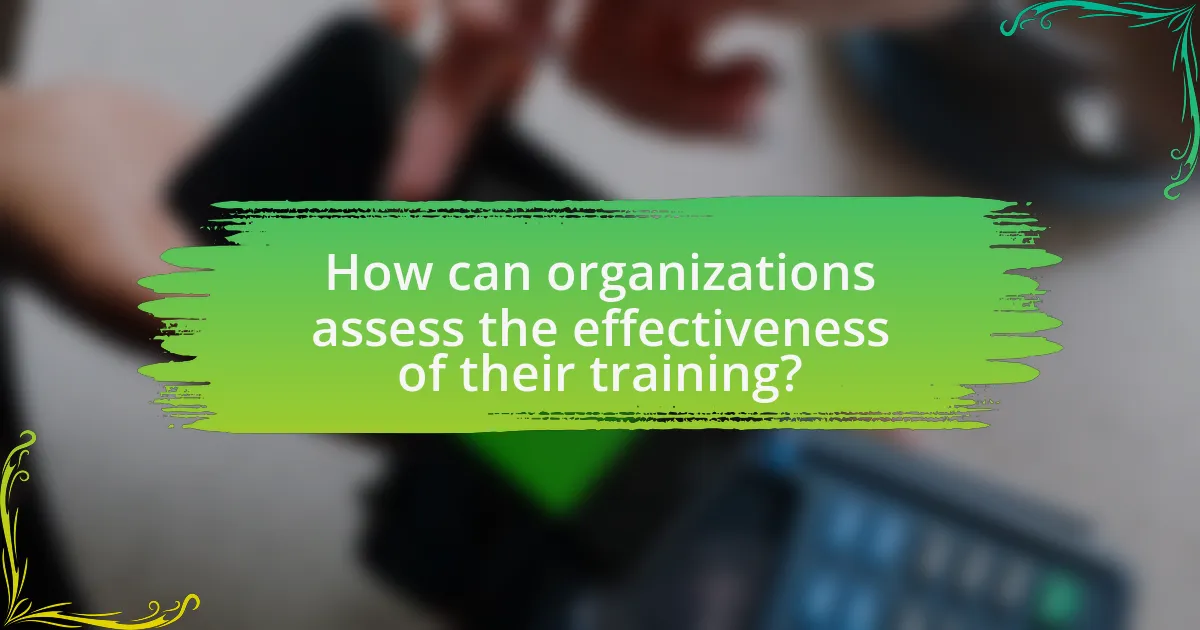The article focuses on training staff on payment security protocols for events, emphasizing the importance of safeguarding sensitive financial information during transactions. It outlines key components of effective training programs, including the necessity of staff education on security measures such as SSL encryption and PCI DSS compliance. The article also discusses the potential risks of inadequate training, the role of simulations in enhancing learning, and best practices for ongoing education in payment security. Additionally, it highlights methods for assessing training effectiveness and the importance of continuous learning resources to keep staff updated on evolving security threats.
What are Payment Security Protocols for Events?

Payment security protocols for events are standardized methods designed to protect sensitive financial information during transactions. These protocols include measures such as Secure Socket Layer (SSL) encryption, which secures data transmitted over the internet, and Payment Card Industry Data Security Standard (PCI DSS) compliance, which establishes security requirements for organizations that handle credit card information. Implementing these protocols helps prevent data breaches and fraud, ensuring that both event organizers and attendees can conduct transactions safely.
How do Payment Security Protocols protect event transactions?
Payment security protocols protect event transactions by encrypting sensitive data and ensuring secure communication between parties involved in the transaction. These protocols, such as SSL/TLS, create a secure channel that prevents unauthorized access and data breaches during the payment process. For instance, according to the Payment Card Industry Data Security Standard (PCI DSS), compliance with these protocols is essential for safeguarding cardholder information, which significantly reduces the risk of fraud and enhances consumer trust in the transaction process.
What types of threats do these protocols mitigate?
These protocols mitigate threats such as data breaches, fraud, and unauthorized access. Specifically, they protect sensitive payment information from being intercepted during transactions, thereby reducing the risk of identity theft and financial loss. For instance, encryption protocols like TLS (Transport Layer Security) ensure that data transmitted over networks is secure, making it difficult for attackers to access or manipulate sensitive information. Additionally, authentication protocols help verify the identity of users, further preventing unauthorized access to payment systems.
How do these protocols ensure data integrity?
Protocols ensure data integrity by employing mechanisms such as checksums, cryptographic hashes, and digital signatures. These mechanisms verify that data remains unchanged during transmission or storage, detecting any alterations or corruption. For instance, checksums calculate a value based on the data content, allowing for quick verification upon retrieval. Cryptographic hashes, like SHA-256, create a unique fingerprint of the data, ensuring that even a minor change results in a completely different hash. Digital signatures provide authentication and non-repudiation, confirming the sender’s identity and that the data has not been tampered with. These methods collectively maintain the accuracy and reliability of data throughout its lifecycle.
Why is training staff on Payment Security Protocols essential?
Training staff on Payment Security Protocols is essential to protect sensitive financial information and prevent data breaches. Effective training equips employees with the knowledge to recognize potential security threats, adhere to compliance regulations, and implement best practices in handling payment transactions. According to the 2021 Verizon Data Breach Investigations Report, 85% of data breaches involve human error, highlighting the critical role that well-trained staff play in safeguarding payment systems.
What are the potential risks of inadequate training?
Inadequate training poses significant risks, including increased vulnerability to security breaches and financial losses. When staff lack proper knowledge of payment security protocols, they may inadvertently expose sensitive customer information, leading to data theft or fraud. For instance, a study by the Ponemon Institute found that organizations with insufficient training experienced a 50% higher likelihood of data breaches compared to those with comprehensive training programs. Additionally, inadequate training can result in non-compliance with industry regulations, which may incur legal penalties and damage an organization’s reputation.
How does trained staff enhance overall event security?
Trained staff enhance overall event security by effectively identifying and responding to potential threats. Their training equips them with the skills to recognize suspicious behavior, manage crowd control, and implement emergency protocols. For instance, a study by the International Association of Venue Managers found that events with trained security personnel experienced 30% fewer incidents compared to those without. This demonstrates that well-prepared staff can significantly mitigate risks and ensure a safer environment for attendees.
What are the key components of an effective training program?

The key components of an effective training program include clear objectives, relevant content, engaging delivery methods, assessment mechanisms, and ongoing support. Clear objectives define what participants should achieve, ensuring alignment with organizational goals. Relevant content addresses specific skills and knowledge needed for payment security protocols, enhancing applicability. Engaging delivery methods, such as interactive workshops or simulations, increase retention and participation. Assessment mechanisms, like quizzes or practical evaluations, measure understanding and effectiveness of the training. Ongoing support, including resources and follow-up sessions, reinforces learning and adapts to evolving security challenges.
How should the training content be structured?
Training content should be structured in a modular format that includes clear objectives, engaging materials, practical examples, and assessments. This approach allows for focused learning on specific aspects of payment security protocols, ensuring that staff can easily grasp and retain critical information. Each module should begin with defined learning outcomes, followed by interactive content such as videos or case studies that illustrate real-world applications. Incorporating assessments at the end of each module helps reinforce knowledge and gauge understanding, which is essential for effective training on payment security protocols in events.
What topics should be included in the training curriculum?
The training curriculum should include topics such as payment security protocols, data protection regulations, fraud detection techniques, secure payment processing methods, and incident response procedures. These topics are essential for ensuring that staff understand the importance of safeguarding sensitive payment information and complying with legal requirements. For instance, knowledge of the Payment Card Industry Data Security Standard (PCI DSS) is crucial, as it outlines security measures that organizations must implement to protect cardholder data. Additionally, training on recognizing phishing attempts and other social engineering tactics can help staff prevent unauthorized access to payment systems.
How can real-life scenarios be integrated into the training?
Real-life scenarios can be integrated into training by using case studies and role-playing exercises that simulate actual payment security situations. These methods allow staff to engage with realistic challenges they may face during events, enhancing their problem-solving skills and decision-making abilities. For instance, presenting a scenario where a data breach occurs during an event can help staff practice their response strategies in a controlled environment, reinforcing the importance of security protocols. Research shows that experiential learning, such as simulations, increases retention of information by up to 75%, making it an effective approach for training staff on payment security protocols.
What methods can be used to deliver the training?
Training can be delivered through various methods, including in-person workshops, online courses, and interactive simulations. In-person workshops allow for direct engagement and immediate feedback, which can enhance understanding of payment security protocols. Online courses provide flexibility and accessibility, enabling staff to learn at their own pace while covering essential topics. Interactive simulations offer practical experience in a controlled environment, allowing staff to apply their knowledge in realistic scenarios. These methods collectively ensure comprehensive training on payment security protocols for events.
How effective are online training modules compared to in-person sessions?
Online training modules are generally as effective as in-person sessions for training staff on payment security protocols, with some studies indicating that online formats can enhance learning retention and flexibility. Research published in the Journal of Educational Psychology found that online training can lead to similar or even superior outcomes in knowledge retention compared to traditional classroom settings, particularly when interactive elements are included. Additionally, a meta-analysis by the U.S. Department of Education revealed that students in online learning conditions performed better, on average, than those receiving face-to-face instruction, especially when the online training is well-structured and engaging.
What role do simulations play in staff training?
Simulations play a critical role in staff training by providing realistic, hands-on experiences that enhance learning and retention. They allow staff to practice payment security protocols in a controlled environment, enabling them to develop skills and confidence without the risk of real-world consequences. Research indicates that experiential learning, such as simulations, can improve knowledge retention by up to 75% compared to traditional training methods. This effectiveness is particularly important in high-stakes environments like event management, where staff must respond quickly and accurately to security challenges.
How can organizations assess the effectiveness of their training?

Organizations can assess the effectiveness of their training by implementing evaluation methods such as pre- and post-training assessments, participant feedback surveys, and performance metrics analysis. Pre- and post-training assessments measure knowledge retention and skill acquisition, providing quantitative data on learning outcomes. Participant feedback surveys gather qualitative insights on training relevance and engagement, helping to identify areas for improvement. Performance metrics analysis involves tracking key performance indicators related to payment security protocols, such as error rates or compliance levels, to evaluate the real-world impact of the training on staff performance. These methods collectively provide a comprehensive view of training effectiveness, ensuring that organizations can make informed decisions for future training initiatives.
What metrics should be used to evaluate training success?
To evaluate training success, key metrics include knowledge retention, behavior change, and performance improvement. Knowledge retention can be assessed through pre- and post-training assessments, which measure the increase in understanding of payment security protocols. Behavior change can be evaluated by observing staff adherence to security practices during events, indicating the practical application of learned skills. Performance improvement can be quantified by analyzing incident reports or security breaches before and after training, demonstrating the effectiveness of the training in reducing risks. These metrics provide a comprehensive view of training effectiveness in enhancing staff capabilities regarding payment security.
How can feedback from staff improve future training sessions?
Feedback from staff can significantly enhance future training sessions by identifying specific areas for improvement and tailoring content to meet the needs of participants. When staff provide insights on the effectiveness of training materials, delivery methods, and overall engagement, organizations can adjust their training strategies accordingly. For instance, a study by the Association for Talent Development found that organizations that actively seek and implement employee feedback see a 14% increase in training effectiveness. This data underscores the importance of incorporating staff perspectives to create more relevant and impactful training experiences.
What follow-up assessments can reinforce learning?
Follow-up assessments that can reinforce learning include quizzes, practical demonstrations, and feedback sessions. Quizzes assess retention of knowledge and can highlight areas needing improvement, while practical demonstrations allow staff to apply learned concepts in real-world scenarios, reinforcing their understanding. Feedback sessions provide opportunities for discussion and clarification, ensuring that staff can address any uncertainties. Research indicates that active engagement through these methods significantly enhances retention and application of training material, as evidenced by studies showing improved performance in environments where follow-up assessments are utilized.
What are best practices for ongoing staff training on Payment Security Protocols?
Best practices for ongoing staff training on Payment Security Protocols include regular training sessions, practical simulations, and updates on the latest security threats. Regular training sessions ensure that staff are consistently informed about the protocols and any changes in regulations, while practical simulations allow staff to apply their knowledge in real-world scenarios, enhancing retention and understanding. Additionally, providing updates on the latest security threats, such as phishing attacks or data breaches, keeps staff aware of potential risks and reinforces the importance of vigilance. According to the Payment Card Industry Data Security Standard (PCI DSS), organizations must maintain a security awareness program to educate employees about security risks, which supports the necessity of these training practices.
How often should refresher courses be conducted?
Refresher courses should be conducted annually. This frequency ensures that staff remain updated on the latest payment security protocols and practices, which are crucial in a rapidly evolving technological landscape. Research indicates that regular training helps reinforce knowledge and skills, reducing the likelihood of security breaches. For instance, the National Institute of Standards and Technology recommends ongoing training to maintain compliance with security standards.
What resources are available for continuous learning in payment security?
Resources available for continuous learning in payment security include online courses, industry certifications, webinars, and professional organizations. Online platforms such as Coursera and Udemy offer courses specifically focused on payment security, while certifications like Certified Information Systems Security Professional (CISSP) and Payment Card Industry Professional (PCIP) provide recognized credentials. Webinars hosted by organizations such as the PCI Security Standards Council and the International Association for Privacy Professionals (IAPP) offer up-to-date information on best practices and emerging threats. Additionally, joining professional organizations allows access to a network of experts and ongoing educational resources.






